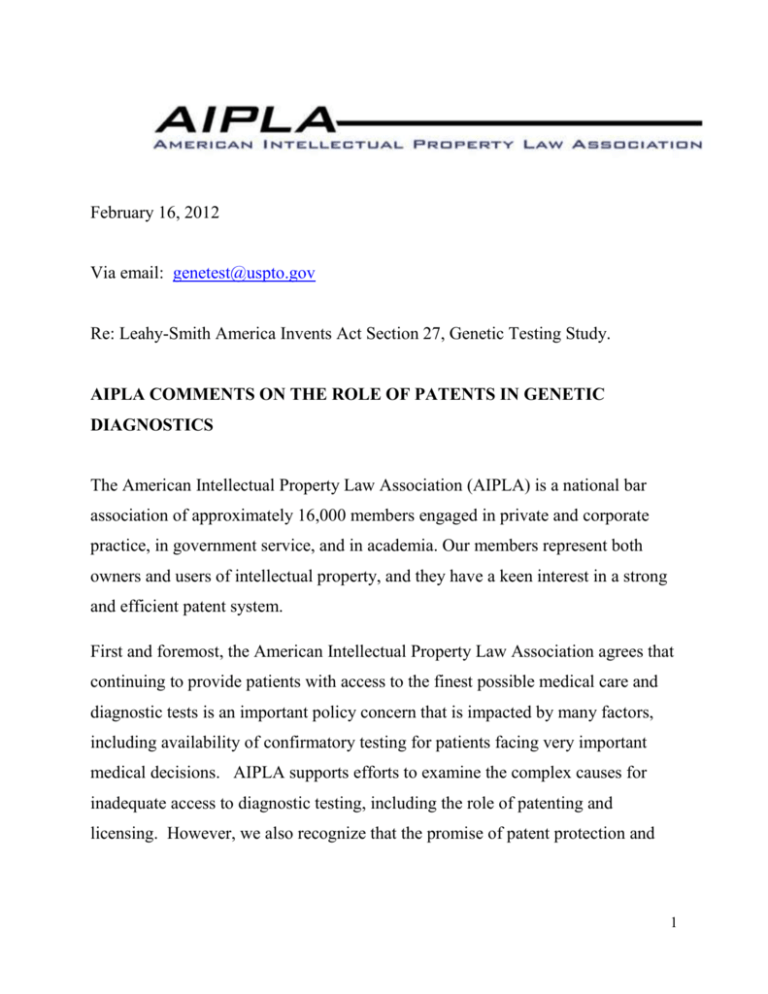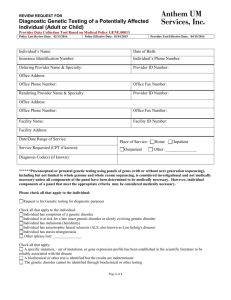20120217 AIPLA Testimony USPTO Genetic Testing Study
advertisement

February 16, 2012 Via email: genetest@uspto.gov Re: Leahy-Smith America Invents Act Section 27, Genetic Testing Study. AIPLA COMMENTS ON THE ROLE OF PATENTS IN GENETIC DIAGNOSTICS The American Intellectual Property Law Association (AIPLA) is a national bar association of approximately 16,000 members engaged in private and corporate practice, in government service, and in academia. Our members represent both owners and users of intellectual property, and they have a keen interest in a strong and efficient patent system. First and foremost, the American Intellectual Property Law Association agrees that continuing to provide patients with access to the finest possible medical care and diagnostic tests is an important policy concern that is impacted by many factors, including availability of confirmatory testing for patients facing very important medical decisions. AIPLA supports efforts to examine the complex causes for inadequate access to diagnostic testing, including the role of patenting and licensing. However, we also recognize that the promise of patent protection and 1 the right to license diagnostic testing inventions create important incentives for inventors and owners to pursue and fund development of those tests. AIPLA believes that the non-patent factors may in fact be more important in determining whether a confirmatory diagnostic test will be available to a US patient. A principal factor is whether the test will be paid under relevant Medicaid, Medicare, and private payer policies. Additional factors include the effects of FDA regulations, contractual limitations, institutional policies, malpractice and other tort concerns, practice patterns, professional talent distribution, financial and time restraints, and more. In some situations, anti-kickback, health care fraud statutes, and government reimbursement policies may also serve as barriers to diagnostic companies who would otherwise elect to offer tests at little or no cost based on financial need. To the extent that patient concerns suggest that multi-source tests should be mandated, AIPLA believes that patent protection can assist in ensuring that those offering a test are properly qualified to do so, that data bases are properly maintained, and that important testing information relating to reliability will be made available to the FDA and other regulatory authorities. More importantly, criticisms of how a given diagnostic patentee may have chosen to commercialize its test are more than outweighed by other factors. Most diagnostic tests would never have been developed or commercialized in the first place were it not for the incentives and protections offered by our patent system. The United States patent system, with its high standards for patentability, high predictability, robust enforcement provisions, and strong licensing tradition, has been and will continue to be essential to the creation and commercialization of diagnostic tests that benefit patients. It is still the best system for promoting 2 “progress of the useful Arts” and for bringing a steady stream of innovative products and services into our economy. Without commercially-available tests, no patients have access, even to primary tests. Unfortunately, the essential role patents and licensing play in bringing diagnostic testing to market is not widely understood. Insufficient knowledge about patenting and licensing of such tests, about the relationship between genetic patents and product commercialization, and about the complexity of the genetic diagnostic business, can lead to misunderstandings and misconceptions. This can lead to misplaced legislative and judicial efforts to weaken or eliminate patents. Fortunately, these concerns have been demonstrated to be unfounded in repeated studies of the issue. These studies have instead determined that current laws permitting patenting and licensing of genetic tests do not restrict availability of genetic tests. The American Intellectual Property Law Association believes that it would be a mistake to weaken the patent system to resolve issues not demonstrated to have been caused by the patent system. Objective consideration of data from several well-respected studies requires a conclusion that patenting, on balance, promotes rather than hinders patient access to health care. We cannot lose sight of the fact that our patent system is based on a dual benefit. The Constitutional mandate of a limited reward for invention and discovery is balanced against the duty of the patentee to disclose the invention. By encouraging invention, new technology is given to the public in perpetuity. While some might say this cost is high, it is a short-term cost whose long-term return in patient care, technology access, and future innovation has proven, over and over again, to give a vastly net positive benefit to the public. This system for advancing innovation has 3 served the U.S. economy well. This is demonstrated by the rapid public dissemination of human genomic data and concomitant rapid growth of the biotechnology industry in the United States, while countries with weaker patent systems lagged behind. Today, we are beginning to see the promise of personalized medicine that is increasingly visible in approved genetic diagnostic products and services. These new genetic diagnostic tools do not simply identify if a person is at risk for disease, but offer particular answers to a patient's expected prognosis, response to a particular drug, the correct dose for a patient, and much more. This new era of personalized medicine requires even greater innovation to meet the needs of the different groups of people that need and respond to different treatments. Said another way, application of bioinformatics is expanding the need for innovators and adaptation of new observations to practical solutions. We need more, not less innovation, and the patent systems’ quid pro quo relating to invention disclosure is more important than ever. We need to continue to encourage the use of open disclosure rather than reliance on limited licensing and trade secrets that hold new discoveries as closely guarded corporate property. Rapid advancement of these tools and the recent lawsuit against Myriad Genetics challenging gene and genetic medical diagnostic patent claims has caused the patent system to fall under intense scrutiny once again. Even though the practices of a few actors have been questioned, the few cases where technology has been sequestered or priced beyond the reach of the general public are relatively small in number, and even these actors are beginning to change their behavior in light of public scrutiny. 4 We note that the impact of patenting on the availability of healthcare and diagnostic testing has been studied and reported many times. The HHS Secretary's Advisory Committee on Genetics, Health, and Society (SACGHS) conducted a study on the impact of gene patenting and licensing practices on patient access to genetic tests. The Study arose from suggestions that patents may be limiting the availability, cost, and/or quality of genetic tests. It was also suggested that patents could potentially be responsible for quality control issues, for example where an exclusive license to a single test lab might prevent verification of test results by unlicensed labs. The Report1 acknowledges a tradeoff between potential social costs incurred from patents relating to genetic testing and the incentives provided by patents to develop new genetic tests. AIPLA believes, however, that the Report overstates those costs and fails to adequately value the incentives derived from patents. Notwithstanding the Report’s conclusion of a lack of evidence that patents pose any problem with access to genetic testing, it nevertheless concludes that there are, or will be, problems and leaves it to commentators to make the contrary case. A dissenting opinion from the Report is worth quoting:2 it is our position that statutorily modifying the gene patent system, including the creation of exemptions from liability for infringement upon such patents as defined in this report and proposed in the recommendations, would be more harmful than helpful to patient access and to the quality of innovative genetic diagnostics. 1 2 2010 Secretary's Advisory Committee on Genetics, Health, and Society _______________ STATEMENT OF DISSENT FROM MS. ASPINALL, DR. BILLINGS, AND MS. WALCOFF 5 The dissent emphasized the role that Medicaid and Medicare, as well as private payers, and other factors such as practice patterns and professional talent distribution, play in determining which genetic tests are conducted in what regions of the country. Their assessment of the SACGHS data suggested that “clinicians are often significantly limited by contractual and financial barriers placed on them by their institution or cost containment restrictions imposed by public and private payers.” Other countries have also looked at this issue. For example, the Australian Law Reform Commission (ALRC) conducted a multi-year study of the impact of gene patenting on the availability of medical services in Australia, and produced a lengthy report titled “Genes and Ingenuity Report, Gene Patenting and Human Health.”3 The Commission concluded that it had found no firm evidence of increased costs, limited access to genetic testing, lower quality of healthcare services, or lower levels of clinical research and development. However, it did note the existence of excessive worry about hypothetical exploitative activity, but an absence of evidence that patent holders were aggressively enforcing their patents against genetic testing laboratories. Consequently, the Commission concluded that there were no grounds to justify changing Australia’s patent laws, that the patent system was adequate to handle the situation as it existed, that any reforms should not be based solely on extremely difficult or hypothetical cases (such as Myriad), and that all reforms should conform with Australia’s international IP obligations, particularly TRIPs.4 Most pertinently, the Commission recommended against a medical or diagnostic treatment exemption in the absence of demonstrable harm for fear of hampering healthcare innovation. It also recognized that framing the scope of the exemption would be difficult. 3 4 Full cite needed. Need cites. 6 Likewise, in 2009-2011, a committee of the Australian Senate, while considering a bill to ban patents on biological materials that are substantially the same as those found in “nature,” reviewed prior studies of the impact of gene patenting and took additional testimony.5 The committee concluded, in part: 1) “No evidence received by the committee that patents on human genes or biological materials are systematically leading to adverse impacts on the provision of healthcare in Australia.”6 2) The bill would not resolve the issue concerning BRCA1 and BRCA2 genetic testing.7 3) The bill could lead to significant adverse consequences for healthcare, including delays for access to new diagnostic tests, medicines and treatments, reduced access to clinical trials, and reduced investment in medical R&D in Australia.8 In summary, these and other studies examining the impact of patenting on continuing research and on patient access to medical diagnostics have failed to demonstrate a net negative impact of intellectual property. Rather, they each 5 Australian Senate, Legal and Constitutional Affairs Legislation Committee, Patent Amendment (Human Genes and Biological Materials) Bill 2010. September 2011. 6 Id. 61. 7 Cite needed. 8 Cite needed. 7 determined exactly the opposite. The potential for other, non-patent factors to negatively impact patient access to confirmatory diagnostic testing may be more relevant than patenting. It may be that patients who undergo genetic testing may have reason to doubt the accuracy of a specific genetic test or the performance of the test by the particular test laboratory. However, addressing the perceived problem by limiting intellectual property rights does not appear to be an effective solution. Instead, confirmatory testing should be addressed on a global scale by working with test providers and technology licensors to establish best practices for licensing. We can point at the approaches recommended by AUTM, OECD, and the NIH, which have been adopted by many test providers.9 In conclusion, the American Intellectual Property Law Association believes any change in the patent statute: 1) should be made only on the basis of credible and substantial evidence that access to confirmatory testing is being broadly restricted and that the change will improve access; 2) must include reasonable compensation to the patent owner or exclusive licensee if the change would render patents non-enforceable; and 3) must be very narrowly tailored. The legislative proposals in2011 that preceded the enacted form of Section 27 did not meet these criteria. AIPLA does not support legislation limiting patent rights 9 Cite the 9-points and the others’ policies. 8 in genetic diagnostics without clear evidence that such legislation is required. Innovation and economic growth in the growing genetic diagnostics industry should not be constrained absent a definitive and overriding need. The American Intellectual Property Law Association appreciates the opportunity to present comments on this important issue. We will present additional detailed written comments in due course. 9






